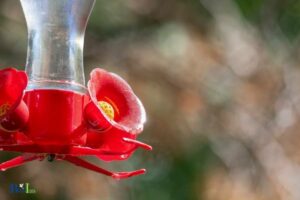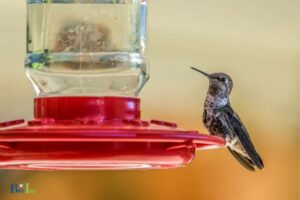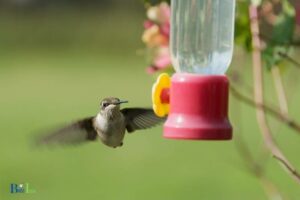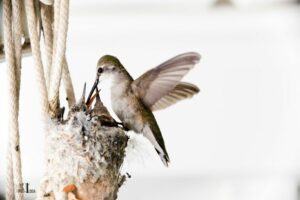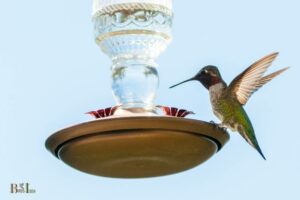When to Put Out Hummingbird Feeders in Ct: Apr-May
The best time to put out hummingbird feeders in Connecticut is from mid-April to early May.
Hummingbirds, specifically the Ruby-throated Hummingbird, migrate northward during the spring season. They typically arrive in Connecticut from mid-April to early May, depending on weather conditions and food availability.
By putting out hummingbird feeders during this time, you can provide a valuable source of nectar for these tiny birds as they visit your area.
Setting up a hummingbird feeder in Connecticut during the appropriate time can attract and support these fascinating birds. By providing a nectar mixture of 1 part sugar to 4 parts water, you can help sustain them during their migration and nesting process.
Remember to clean the feeder at least every 3-4 days to prevent mold growth, ensuring that the hummingbirds have a safe and nutritious food source.
12 Months Timeline: To Put Out Hummingbird Feeders in Ct
| Month | Feeder Status | Note |
| January | Not Recommended | Hummingbirds are not present in CT during winter months. |
| February | Not Recommended | Hummingbirds are not present in CT during winter months. |
| March | Not Recommended | Hummingbirds are not present in CT during winter months. |
| April | Recommended | Early spring migrants may start to arrive. Place feeders out by mid-April. |
| May | Recommended | Peak migration season. Ensure feeders are clean and filled. |
| June | Recommended | Breeding season begins. Feeders are useful for nesting hummingbirds. |
| July | Recommended | Breeding season continues. Keep feeders clean and filled. |
| August | Recommended | Breeding season winds down. Feeders are still useful for late season visitors. |
| September | Recommended | Migrating hummingbirds pass through. Keep feeders filled to support them on their journey. |
| October | Recommended | Last chance to see late migrating hummingbirds. Remove feeders by the end of the month. |
| November | Not Recommended | Hummingbirds have migrated to warmer climates. |
| December | Not Recommended | Hummingbirds are not present in CT during winter months. |
Key Takeaway
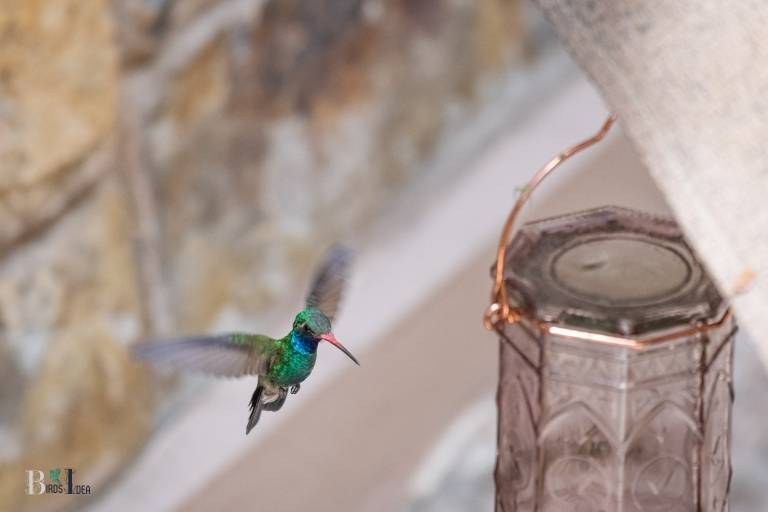
Five Facts About: Put Out Hummingbird Feeders in Ct
Understanding The Timing Of Hummingbird Migration In Ct
When it comes to putting out hummingbird feeders in connecticut, the timing is critical. Understanding when these tiny birds migrate to and from the state can help you ensure that you have your feeders out at the right time.
In this blog post, we’ll explore the timing of hummingbird migration in connecticut and what factors can affect hummingbird migration patterns.
We’ll also share tips on how to track hummingbird migration in connecticut and how to be prepared to welcome these beautiful birds into your yard.
When Hummingbirds Migrate To And From Ct
Hummingbirds are migratory birds that spend their winters in warmer climates in central and south america and the caribbean. In the spring, they fly north to breed, and in the fall, they return south for the winter.
In connecticut, hummingbirds typically migrate to and from the state between april and september.
The exact dates can vary depending on the species of hummingbird and the weather conditions. Ruby-throated hummingbirds are the most common species found in connecticut, and they usually arrive around mid-april and depart by early october.
Factors That Affect Hummingbird Migration Patterns
There are many factors that can affect hummingbird migration patterns, including weather conditions, food availability, and habitat quality.
Hummingbirds need to consume a lot of nectar to fuel their migration, so they rely heavily on the availability of flowering plants.
If there is a late frost or drought, it can reduce the amount of nectar available, which can delay their migration or cause them to travel to other areas. Additionally, habitat loss and fragmentation can make it more difficult for hummingbirds to find food and shelter along their migration routes.
How To Track Hummingbird Migration In Ct
If you’re interested in tracking hummingbird migration in connecticut, there are several resources available. One of the most popular is ebird, a citizen-science project run by the cornell lab of ornithology.
Ebird allows users to report bird sightings, including hummingbirds, and view maps of migration patterns across north america.
The connecticut audubon society also offers information on hummingbird migration in the state, as well as tips on how to create a hummingbird-friendly yard.
To attract hummingbirds to your yard, you can put out feeders filled with sugar water, plant hummingbird-friendly flowers, and provide perches and shelter.
Understanding the timing of hummingbird migration in connecticut is crucial if you want to attract these beautiful birds to your yard. By putting out feeders and creating a hummingbird-friendly habitat, you can help support these important pollinators and enjoy their stunning aerial displays.
When To Put Out Hummingbird Feeders
When To Put Out Hummingbird Feeders In Ct
Hummingbirds are a delight to observe and attract to your garden. However, timing is everything when it comes to putting out hummingbird feeders.
In this section, we’ll explore why timing is vital, the signs to watch out for and provide tips for determining the best time to put out hummingbird feeders in ct.
Why Timing Is Important When Putting Out Hummingbird Feeders
Hummingbirds in ct typically migrate south during the cooler months. But before they leave, they are on the lookout for food sources to store up energy for their long flight.
Timing is crucial when putting out hummingbird feeders because it determines if the birds will find your feeder or not.
Signs To Watch Out For When It’S Time To Put Out Hummingbird Feeders
Keep an eye out for the following signs to know when it is time to put out hummingbird feeders:
- Warmer temperatures: Typically, hummingbirds start arriving in ct in early may when temperatures begin to warm up.
- Blooming flowers: Hummingbirds love nectar-producing flowers, and they are a reliable indicator that it is time to put out hummingbird feeders. When you spot blooming flowers in your yard or neighborhood, it’s time to put out your feeder.
- Sightings of hummingbirds: If you see hummingbirds darting around your garden or your neighbor’s garden, it’s a clear sign that the migration season has started.
Tips For Determining The Best Time To Put Out Hummingbird Feeders In Ct
To ensure you put out hummingbird feeders at the right time, you can use the following tips:
- Track the arrival of hummingbirds in your area: You can use citizen science programs like ebird to track hummingbird migration patterns in your area. This can help you determine the best time to put out your feeder.
- Keep a calendar: Keeping track of when you spot blooming flowers or hummingbirds in your area can help you develop a calendar for putting out your hummingbird feeder each year.
- Monitor the local temperature: Hummingbirds are sensitive to temperature changes, and warmer weather signals the arrival of migration season. Keep an eye on the local temperature and put out your feeder once the temperatures begin to rise.
Timing is crucial when it comes to putting out hummingbird feeders in ct. by tracking migration patterns, keeping an eye on local temps, and monitoring flower blooms, you can attract these beautiful birds to your garden and provide them with a reliable food source.
Setting Up Hummingbird Feeders In Ct
When it comes to attracting hummingbirds to your backyard, setting up a hummingbird feeder is one of the best methods.
However, you need to know the right time to put out hummingbird feeders in connecticut to ensure you get the best results.
Hummingbirds usually arrive in connecticut in early spring, around april. Therefore, it’s best to set up your hummingbird feeders a week or two before they arrive to ensure that you don’t miss them.
Let’s dive deeper into setting up hummingbird feeders in connecticut.
Best Practices For Setting Up Hummingbird Feeders In Ct
Setting up a hummingbird feeder in connecticut requires a bit of care and attention to ensure it’s done correctly.
Here are some best practices you should follow to create the perfect hummingbird feeding area:
- Hang the hummingbird feeders in an open area away from direct sunlight and strong winds.
- Place the feeders about 6 feet off the ground to keep them out of reach of predators.
- Ensure that your hummingbird feeders are easily visible to hummingbirds by placing them near flowers or plants they are known to feed on.
- Use red-colored feeders or place red ribbons or tape near the feeder to attract hummingbirds as they are attracted to red.
- Regularly clean the feeders and refill them with fresh nectar every two to three days.
Different Types Of Hummingbird Feeders And Their Pros And Cons
Several different types of hummingbirds feeders are available, and each has its pros and cons.
Here are three of the most common types:
- Tube feeders: These are long and slender and feature several feeding ports along the length of the tube. They are usually made of glass or plastic and hold a small amount of nectar, making them easy to maintain. However, they can be challenging to clean and may attract bees or wasps to the feeder.
- Saucer feeders: These feeders are flat and bowl-shaped, and the nectar is held in the center of the saucer. They come in a wide range of sizes and are easy to clean and refill. However, they tend to drip nectar, which can attract ants and bees and cause the nectar to spoil more quickly.
- Perky-pet designs: This is a combination of both a tube feeder and a saucer feeder, usually available in plastic or glass. They are easy to clean and refill and come with built-in insect guards, preventing bees and wasps from approaching the feeder. The disadvantage is that they can be tricky to disassemble for cleaning.
Tips For Maintaining Hummingbird Feeders And Keeping Them Clean
To keep your hummingbird feeder clean and maintain its effectiveness, it’s essential to regularly check and clean it.
Here are some tips to help:
- Clean the hummingbird feeders with hot water and a mild detergent to remove any residual sugar or mold.
- Use a bottlebrush or a toothbrush to clean any hard-to-reach areas.
- Regularly remove and clean any removable components, such as the tube, feeding ports, or saucer.
- Never use dish soap to clean the nectar reservoir as it can leave soap residue and harm the hummingbirds.
- Always use fresh nectar and avoid using artificial dye or sweeteners.
By following the above practices and tips, you’ll be able to create a welcoming hummingbird habitat in your backyard. Remember to keep the feeders clean and filled with fresh nectar, and you’ll enjoy watching these delightful birds as they feed and entertain you.
FAQ For When To Put Out Hummingbird Feeders In Ct
What Is The Best Time To Put Out Hummingbird Feeders In Ct?
How Often Should You Refill Your Hummingbird Feeders?
What Kind Of Food Attracts Hummingbirds In Ct?
Where Is The Best Place To Hang Your Hummingbird Feeder In Ct?
Conclusion
As we draw our discussion on when to put out hummingbird feeders in ct to a close, it’s worth noting that the timing of feeder deployment in connecticut is crucial to attracting and keeping hummingbirds.
By understanding the migratory patterns of these beautiful birds, homeowners in connecticut can have a more successful hummingbird feeding season.
Early may marks the beginning of the breeding season when hummingbirds arrive in large numbers from their winter homes in central america. It is advisable to have a feeder in place by then and have it serviced and cleaned regularly.
With the appropriate feeder placement and food preparation, you can attract these lovely birds all summer long. Remember, to avoid pesticides near the feeding areas and keep your feeders clean to protect the hummingbirds from infections and diseases.
With these tips, you are sure to have an enjoyable hummingbird watching experience.

